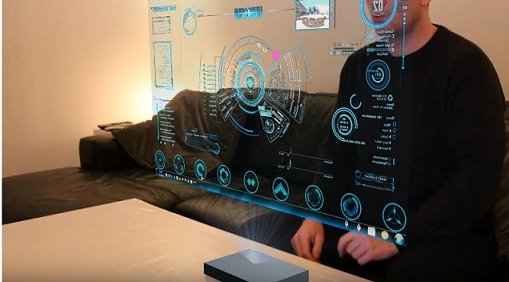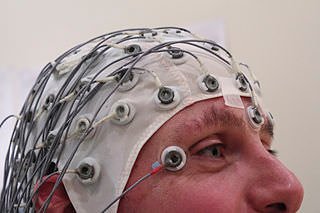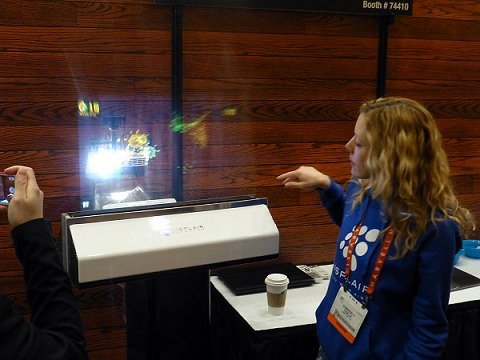Holy Grails Of Screenless Video Technology
Introduction
Have do you receive and retrieve video (visual) information from the source? Okay I know some would say "through the use of LCD (Liquid Crystal Display) or LED (Light Emitting Diode) screens". At least, they have replaced the ancient Cathode Ray Tubes (CRT) television/monitor that our grandpas made use of. But even with the preferability of the LCD and LED over the CRT, it is no longer at the apex of the video display technology. Have you ever thought about having the possibilities where visual information can be propagated without using the conventional screens? That's exactly what we'll be looking at in this post. Join me as we take this ride together.

[Image Source: Screenshot from YouTube Video. Author: GawinX. 37seconds From starting]
The waves of technological advancements that have been witnessed in this era has been evident in almost every aspects of our human existence. Since the first television set was invented in the year 1927 [ref], there have been advances to design newer, better, and more viable versions of it. But as it were, it seems the technology of screens is about to go into oblivion; as some replacements have arisen. First of all, we will be looking at a major contender which allows visual information to be propagated completely devoid of any type of screen whatsoever.
Synaptic Interface System (Brain-Computer Interface)
This is one of the emerging technologies that have been making waves lately. This is also known as "Computer Telepathy", which enables information created or stored in the computing system to be directly sent to the brain without using any screen or intervening medium. In this type of technology, the need for "light" is completely sidelined. Some could be asking; what's the need of using this type of system, and why not just display the damn file on a computer screen?
Okay here's the thing: Have you ever taken time to ask yourself how blind people would have the privilege of interacting with their physical environment? - I mean; to know what colour, shapes, and structures are. This is the technology that would provide solution to these challenges, because there would be no need for eyes in the first place. So how is this achieved? First of all; to have a baseline knowledge about Brain-Computer Interface, check out this post. For effective communication to occur, there must be a BCI receiving device (which could be in form of a brain chip implant - for the case of the invasive type of BCI. Or just an Electroencephalogram headset - for the case of non invasive BCI), which has the function of picking up the signals as they are generated by the computer and sending them as electrical impulses to the brain for interpretation as either audio file, text file, image file or video file.

[Image Source: Wikimedia Commons. Author Chris Hope CC BY 2.0 Licensed]
However, people have had some forms of reservations about the technology of BCI - I mean, who would be willing to go through a surgical procedure just to get a chip in the brain? And also, the other non invasive EEG headset; which would have provided an alternative to the brain chip implant; does not relay high quality signals to the brain - well, this is because, when signals pass through the thick skull, they would be attenuated or lost. But another technology can be used in lieu of the BCI - so the data wouldn't be sent directly to the brain, but to the retina.
Virtual Retinal Display System (VRD)
The retina; as we all know; is the area of the eye that is receptive to light from the optic lens. Okay, just as you've guessed, in this type of screenless display system, light is the transmission medium; as against brain waves in the case of BCI. But unlike the conventional display system, the Retinal display system focuses the computer-generated data directly in the retina through the help of a specialized Retinal Projector. Though this could be grouped as emerging technology, but the idea behind this has been age-long. As a matter of precision, mention was made of it (though remotely) by Dr Kazuo Yoshinaka as far back as the year 1986 [ref], but there were little or no complementary advances made in it until very recently. And ever since then, it has drawn some considerably fair attentions. I'm sure you're piqued to know how this technology looks like. Okay take a quick peek into this YouTube video for insight.
This technology is built on the principle of the natural eye's vision, which picks up reflected light and transfers it directly to the pupil. I know you're wondering if this is not the same thing as placing a screen in front of your eyes. Okay here's the real deal: If you're familiar with the technology of the traditional LED, LCD or CRT screens, you would agree with me that they generate light rays but they are not particularly emissive (the kind of light your natural vision/eyesight is adapted to). Okay try placing an LCD screen in front of your eyes for a long period and observe what would happen to your eyes - definitely, it wouldn't be humorous.
But in the case of the virtual retinal display, the retinal projector reflects only emissive light, which is made possible by the projector's micro-mirror that looks just like the eye's optic lens. So by inference, the light is focused directly into the pupils, then the image would be formed in the retina. And to ward off probability of damage to the eyes, the retinal display makes use of extremely low-density light, so it would feel comfortable passing it through the eyes for an extended period without damage to the eyes. With this kind of display, it would feel as if you are directly interacting with the video source (the realism here is the main focal point, which is also the side attraction) - just look at it as an enhanced Virtual Reality. Though, in the traditional Virtual Reality, the projection does not track your eyes (it is more like having a miniature LCD placed in front of your eyes), but in the newer technology of Virtual Retinal Display, Tracking-Eye-Movement is incorporated into it; so as your eyeballs move, the micro-mirror projector moves along with them, so the transmission is perfectly steady (no pixelization whatsoever).
One of the advantages of this display; just like the technology of BCI; is Privacy. This is because, the data is sent to the targeted recipient directly without passing through intervening medium. And with this, classified data can be shared with ultimate secrecy, without the fear of data compromise. But on the downside, these technologies (BCI and VRD), because they are still emerging, they are a little cost ineffective for low income earners. But hey! There's another screenless display I'd love to show you.
Fog/Vapour Display
We all know what fog is, but for the uninitiated, they are tiny droplets of water dispersed in air. At much concentrated form, it can impair visibility. But do you know that this can actually serve as a display device? Okay now you're knowing. But how does it work? It is worthy to note that what is being used is not the natural fog, but a simulation of it. This is created with the Haze Machine, which produces a cloud-like effect within a controlled environment. The video is then projected onto the simulated cloud.

[Image Source: Wikimedia Commons. Author: David Berkowitz. CC BY 2.0 Licensed]
This has an advantage over Virtual Retinal Display and the Brain-Computer Interface Display because it is cost effective and doesn't require more than just Haze machine and the video projector to create a display - This is just like viewing video in the cloud. But as it were, the disadvantage in this is the fact that haze cannot be effectively produced outside (like an open space under the sun. Of course, this would affect the dispersion of the haze). It is best used within a controlled environment - example: in studio, theatre, etc. So you see, you can watch that your movie without using a screen.
Conclusion
Before now, one of the major media of retrieving or viewing video file was through screens, but with the advances in technology, more alternatives have arisen - which are grouped as "screenless display system". We have seen that it is possible to propagate video data without using screens. There is actually no limit to how technology can evolve.
Thanks for reading
References for further reading:
- HowStuffWorks/Brain-Computer-interface
- Techtarget/BCI display
- Concept of Virtual Retinal Display
- 3D fog display


gif by @foundation
sooner or later this will be a thing. If you recall years ago we saw in movies tablet and smartphones like devices that just we a touch of the hand could do things. A couple of years later and boom Iphones, tablets,androids that use touchpad technology.
The next step is this screenless technology!
Exactly buddy. Technological advancement is in phases. Maybe the era of screens is almost going into oblivion
Awesome read @samminator, most of the informations here are new for me. However, i have some concerns
Concerning the above, there are changes that occur in the brains of people once they go blind. The brain restructures itself to adapt to the new situation Find more information here
And no thanks, i dont want a chip implanted in my brain, lol, Nicee post once again.
I'm sure you've heard of Neil Hardisson who was born blind. He got an antenna implant in his brain that enabled him to sense colours.
What of the people that are born blind, does the neuroplasticity apply to them too?
Thanks for coming around
Quite a technology....... It get better everyday
I have been seeing most of all this stuffs in TV and movies, was finding it hard to believe that they really exist. Now I know they do
Yes they do exist. And there is no limit to how advanced technology can evolve
Ineed there is no limit to technology.
This is another complicated tech, that to me
But it actually cool if it can actually help the blind.
Lol. Don't worry, with time, you'll get used to technology. Maybe before 2089 😂😂😂. I'm kidding.
Thanks for coming
This post has been voted on by the steemstem curation team and voting trail.
There is more to SteemSTEM than just writing posts, check here for some more tips on being a community member. You can also join our discord here to get to know the rest of the community!